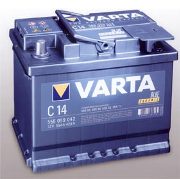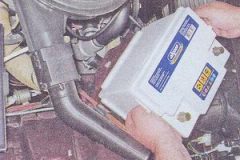Categories: Featured Articles » Sharing experience
Number of views: 184,858
Comments on the article: 3
Car batteries - how they work, how they work, tips for use and charging
 The most significant in car batteries are the following three indicators:
The most significant in car batteries are the following three indicators:
Firstly, it is a capacity expressed in ampere hours. It characterizes the ability of the battery to give a certain current for a certain time. For example, a capacity of 40 ampere-hours means that the battery can give a current of 1 ampere for 40 hours (or 2 amperes for 20 hours, etc.)
Thirdly, reserve capacity. This parameter, especially revered in America, shows the time interval (in minutes) during which the battery is capable of delivering a current of 25 A (i.e. for how long it can replace a failed generator).
What is inside?
A standard car battery consists of six 2-volt cells, which gives 12 volts at the output. Each element consists of lead grating plates coated with an active substance and immersed in an electrolyte. Negative plates are coated with finely porous lead, and positive plates are coated with lead dioxide. When a load is connected to the battery, the active substance enters into a chemical reaction with a sulfuric acid electrolyte, producing an electric current. In this case, lead sulfate is deposited on the plates, and the electrolyte, accordingly, is depleted. When charging, this reaction proceeds in the opposite direction, and the ability of the battery to give current is restored.
The car battery has three functions:
firstly, it starts the engine;
secondly, it feeds some electrical devices, for example, an alarm system and a telephone when the engine is not running.
thirdly, it “helps” the generator when it does not cope with the load.
Idle battery mode
Idle a car in winter in traffic jams is a real problem for the battery. The fan, headlights, rear window heater and wipers operating at the same time can pick up more current than the generator produces. After 45 minutes of such work, the average battery can become so depleted that restarting the engine off is no longer possible. Recovery will require at least 30 minutes of normal driving before you can stop again.
Why do they fail? Actually, there’s nothing to break in the battery itself. In any case, the cause of most of the malfunctions is not due to its own defects, but to the presence of additional equipment, for example, left dimensions, alarms and telephone, leakage current, which is not uncommon on a new car. These devices are especially fond of presenting "surprises" during long car parking, for example, at airports.
In order to save money, car manufacturers put a "weak" battery as much as possible, so any additional electrical load can cause a malfunction.
The battery itself in the process of service, of course, wears out and, in the end, fails. This is due to corrosion of the plates, depletion of their active coating and depletion of the electrolyte. An increased temperature contributes to this, so more often than not, injuries occur in the summer, and a "fun life" begins with the first frost. Typically, the battery life is about four years, but to a large extent depends on the mode of operation.
However, if your battery suddenly begins to junk, do not discard it. Our experience shows that a huge number of car batteries, which were considered faulty, were simply discharged. Try charging a dead battery as soon as possible.The longer the battery remains uncharged, the stronger the sulfation of the plates, and the more problematic it will be to restore.
Battery requires care
 Many car owners are genuinely surprised when they find out that the battery also requires "maintenance." This is unfortunate, because a drop of care and attention can save a ton of time and money.
Many car owners are genuinely surprised when they find out that the battery also requires "maintenance." This is unfortunate, because a drop of care and attention can save a ton of time and money.
Caring for the battery is extremely simple and practically comes down to regular checks of the electrolyte level. A low level may indicate excessive charging, which is usually caused by a malfunction of the generator. If the electrolyte is lacking in only one of the elements, then the failure of the entire battery is just around the corner. In warm weather, he will still work somehow, but the very first cold will finish him off.
A few years ago, “maintenance-free batteries” were in full swing, which was structurally reduced to a blind sealing of the top cover. Over time, this mode has passed, because, if, for some reason, the loss of electrolyte still occurred, it was no longer possible to add it.
Topping up the battery, remember one feature. During charging, the electrolyte level rises slightly, therefore, topping up should be subject to this effect. And what acid can do if it gets on the battery case or on body parts, we all know very well.
Security questions
Remember that the danger of ignition of oxygen and hydrogen released during charging (and also after its completion) is real. Although most serious manufacturers equip battery covers with flame arresters designed to prevent it from getting inside the battery, this likelihood still persists - as they say, God saves the person safe. Remember also that a spark arises not only when the terminal is disconnected. Static electricity from synthetic clothing may be enough to cause an explosion.
A battery explosion can be compared in terms of power with a shot from a 12 mm caliber gun. The result is a terrible sight, and it happens more often than you can imagine. For example, in cautious America, there are more than ten thousand such cases a year.
Despite the fact that the explosion will probably not be fatal, it can seriously injure you, especially your face, as fragments of plastic fly apart in all directions. Therefore, you should always be in safety glasses.
The next point to pay attention to is vibration. After heat and electrical overload, this is the main reason for battery wear. The mechanism of this effect is simple: any "chatter" gradually shakes off the active substance from the plates. Therefore, make sure that the battery is firmly fixed.
Finally, check the terminals. They must be clean and well tightened to avoid arcing. Some grease the terminals with thick grease, others believe that this only contributes to the accumulation of dirt, so the choice is yours.
Charge !!! ....
 A battery that has hopelessly “run down” once on a frosty Monday morning is a common cause of the collapse of so many brilliant service careers.
A battery that has hopelessly “run down” once on a frosty Monday morning is a common cause of the collapse of so many brilliant service careers.
So what to do?
You can try to start the car in several ways: "light up" from the battery of another car (which may be problematic with the current level of "wound" electronics); push the car or pull in tow (but not in the presence of a catalytic converter); go buy a new battery.
The latter method is especially bad, because in the vast majority of cases, a "dead" battery can be restored.
With proper charging, in most cases it is restored to its original state and continues to live and fight further.
Do not rush!
Gone are the days when the battery just connected to charger and left overnight. The battery must be charged at a certain “speed”, otherwise you will encounter various troubles.
Ideally, the charging current for a regular lead-acid battery should be 10% of its ampere-hour characteristic. For example, a fully discharged battery with a capacity of 50 ampere-hours should be charged at a current of 5 amperes for ten hours. Charging should take place with the covers removed.
And I want it faster, but you can’t. This can lead to overheating, and even to boiling of the electrolyte. Plates can also warp, then the battery is the end. If your battery is sealed, “maintenance-free”, then it has to be charged even more slowly - no more than 2.5% of the ampere-hour characteristic.
So, in the same example, a fully discharged sealed battery of 50 ampere hours requires a charging current of 1.25 amperes for 40 hours. For partially discharged batteries this time will, of course, be less.
Most chargers are equipped with a charge current regulator. It is especially convenient if there is a "decreasing charge" mode. In this case, as the battery charges, the charging current automatically decreases, which helps prevent a possible overcharge.
The general rule here is that the slower you charge, the better.
However, do not hold the battery under charge for too long. Regarding the determination of when the process should be completed, opinions differ. Some calculate the time needed for charging and after it turns off the device, others wait until all the elements begin to bubble, and turn off only then.
Some more powerful charging device equipped with quick charge function. It should be used only in emergency situations when you need to start as soon as possible. In this mode, an increased charging current is supplied for a certain period of time, after which the device itself turns off. Battery life is shortened anyway.
See also at i.electricianexp.com
:
